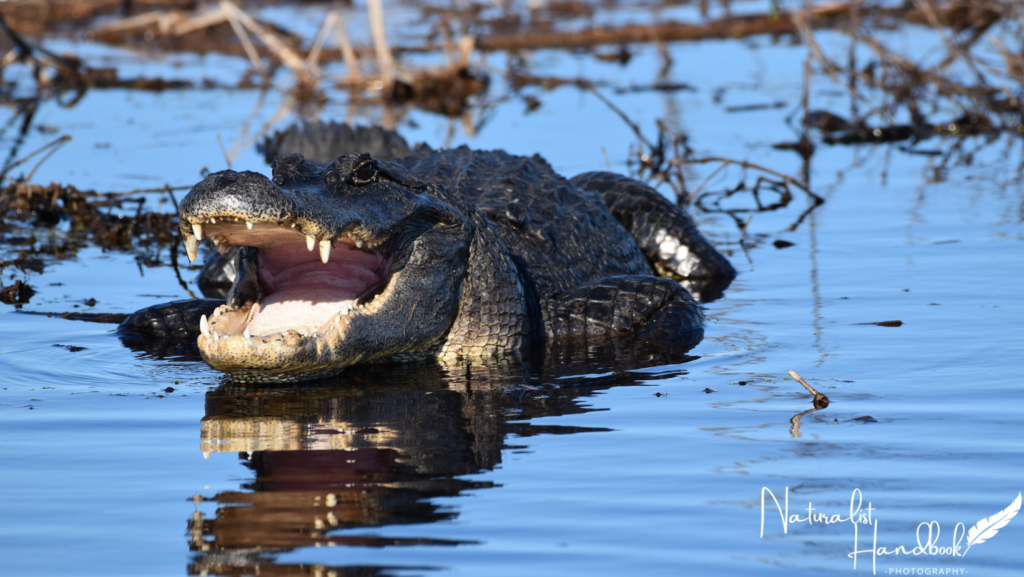American Alligator: Dinosaur of the Wetland

American Alligator
The American alligator is what is commonly known as the Gator. This large reptile is common throughout the southeast of the United States. The American alligator along with the smaller Chinese alligator are the only two species alive today.
American alligators are apex predators in their environment. They strike fear and wonder into the hearts of many viewers. A force to be reckoned with, this large reptile is the master of his domain.
Scientific Classification
- Domain: Eukarya
- Kingdom: Animalia
- Phylum: Chordata
- Class: Reptilia
- Order: Crocodilia
- Family: Alligatoridae
- Subfamily: Alligatorinae
- Genus: Alligator
- Species: A. mississippiensis
Description
The American alligator measures up to 15.1 (4.6 m) feet in length for males and 9.8 feet (3 m) in females. They can weigh up to 1000 lbs. (454 kg).
These animals have dark skin on the dorsal surface that is heavily armored with small bones known as scutes. Light undersides aid in camouflage when viewed from underneath.
They have slightly webbed feet and a powerful tail to glide through the water at a top speed of 20 miles per hour. On land, they can run up to 35 miles per hour, making them faster than you for short distances.
The largest American alligator recorded measured 19 feet 2 inches in Louisiana in 1890. The specimen was too large to weigh, but estimates indicate it may have been around 2200 pounds. As human interaction has encroached on their habitats, the average sizes have diminished to 11 feet for males and 8 feet for females weighing between 121 – 161 pounds.
Range & Habitat
Alligators are found primarily in coastal wetlands in the Southeast portion of the United States. They extend as far west as Texas and north into North Carolina. They inhabit all of the Everglades through Florida.
Habitat preference is slow moving freshwater, but they have been known to roam beaches during periods of drought. They can be seen sunning on golf courses and have been found in swimming pools of unsuspecting homeowners.
Diet & Behavior
The American alligator is a carnivore feeding on anything they can get their teeth onto. They have a powerful jaw combined with sharp teeth that will clamp down and hold onto prey. The jaws of an alligator are strong enough to crack a turtles shell.
They hunt primarily at night where they silently stalk prey through the water and lunge to grasp it. Prey is dragged underwater where it is drowned and consumed. Alligators have throat adaptation that allows them to capture swimming prey underwater without drowning.
Alligators can swim, walk, and run. They are able to lift their entire bodies off of the ground when they walk, making them seem especially large and dangerous. Ominous and beautiful at the same time.
Being a cold-blooded animal, they are known to go dormant during cold periods. To keep from overheating in the hot dry summers, they will sink to the bottom of pools and rest in the mud to protect from the sun’s harsh rays. They are able to hold their breath and stay submerged for up to 24 hours when necessary.
Reproduction & Lifespan
American alligators reach reproductive maturity around 10 -12 years of age. Males use characteristic bellows to attract mates during breeding season from March through May.
Females will create a nest in vegetation where she will lay around 90 eggs on average. She will guard her nest until the young begin to make high pitched squeals inside their eggs. Mother alligators will protect their young for the first few years as many will be eaten by other alligators, fish, birds, snakes, and mammals.
Alligators have rough and unpredictable start in life but begin to be out of danger once they reach four feet in length. This is typically around 5-6 years of age. It is not uncommon for alligators to reach up to 50 years of age.
Fun Animal Facts
The American alligator loses its teeth as they get worn out, they will have up to 3,000 in their lifetime with between 75-80 at once.
Conservation Status
Once threatened, these protected reptiles are off of the Endangered Species List. Many states in their range offer hunting seasons to keep the population maintained. The main threat to these magnificent creatures today is habit loss as humans drain wetlands and expand cities.
Information Sources
National Geographic
National Park Service
Smithsonian’s National Zoo and Conservation Biology Institute
National Wildlife Federation